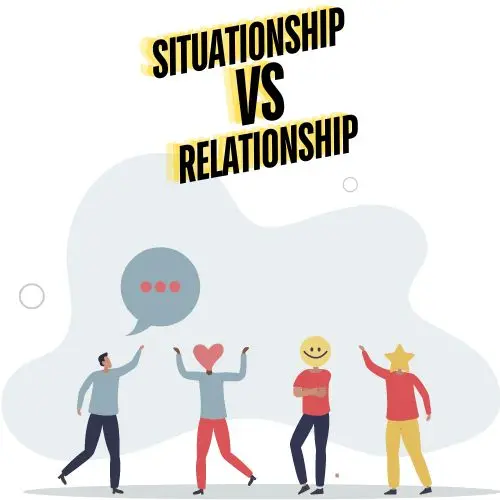Key Stats About Situationships and Committed Partnerships
| Situationship | Relationship | |
|---|---|---|
| Commitment Level | Low – No defined commitments or expectations | High – Committed to one another with agreed-upon expectations |
| Emotional intimacy | Variable – Depends on individuals and circumstances | Deep – High level of vulnerability, trust, and emotional support |
| Future planning | None – Go with the flow mindset | Joint vision and planning for the future together, e.g., living together, marriage. |
| Social media PDA | Rare – Typically not publicized on social networks | Common – Partners integrated into each other’s online profiles and lives |
Situationships have become increasingly common in modern dating culture. But what exactly is a situation, and how does it differ from being in a real, committed relationship? Let’s take a deeper look.
What is a Situationship?
A situationship refers to an intimate connection between two people that is casual or undefined in nature. While situationships may involve kissing, intimacy, and spending quality time together, there is no formal commitment or discussion of exclusivity, long-term plans, or labels for what they are.
It exists in a gray area between just dating and being official partners. There is also typically ambiguity or mixed signals regarding expectations, boundaries, and where the connection is headed. This undefined arrangement often confuses both parties about “what are we?”.
Signs You’re in a Situationship:
- You’ve hooked up or been physically intimate but haven’t formalized the relationship
- You regularly communicate and see each other for dates but haven’t had talks of commitment
- Your interactions are kept private from social media and friends/family
- There is confusion or ambiguity about where the situation is going
- One or both people are keeping their options open by dating or hooking up with others
How Do Situationships Evolve in Modern Dating Culture?

Once viewed as casual flings, situations have become increasingly important in recent years. With busy schedules and an emphasis on independence, dedicated courtship and relationships require more effort.
As a result, ambiguous arrangements allow people to enjoy intimacy and companionship without all the pressure and obligations of being a couple. Situationships offer flexibility and a “try before you buy” dynamic that fits seamlessly into many lifestyles.
The Complex Emotions of Situationships
While the casual flexibility appeals to some, situations often breed inner turmoil. Without clear rules or titles, it’s easy to develop unspoken or one-sided expectations that set people up for confusion and hurt.
Feelings seldom remain static, leading to discrepancies where one person catches stronger feelings while the other remains detached. This emotional limbo leaves people insecure, longing for stability and clarity on where they stand.
Pros and Cons of Situationships:
Potential pros:
- less commitment and pressure to perform in a relationship
- flexibility to see other people or end things easily
- excitement of a “new fling” dynamic that avoids relationship routines
- independence to focus on oneself without an official partner
Potential cons:
- confusion over ambiguous expectations and lack of exclusivity
- difficulty separating feelings from just physical intimacy
- hurt when one person wants more than the other can give
- lack of security, emotional support, and long-term stability
While situations provide certain appeals, all humans crave emotional security and connection on some level. So, ultimately, situations often leave those involved desiring more clarity, communication, and commitment.
- When to have “the talk” to define a situation
- Strategies for transitioning it to a committed partnership if that’s what you want
- Signs it’s time to leave an unfulfilling situation
- Tips for focusing on self-growth, whether single or in a relationship
When to Have “The Talk”

If a situation is causing inner turmoil due to unclear expectations, it’s time to communicate. Having “the talk” lets both parties be upfront about what they want and see if you’re aligned.
Suggestions for having this conversation respectfully:
- Choose a private setting with no distractions when you both feel calm and mentally present.
- Share how you genuinely feel without accusations. Say, “I feel confused…” rather than “You’re confusing me.”
- Listen without judgment to understand their perspective as well. Find understanding, not just verifying your own assumptions.
- Discuss whether you both see long-term potential or if it will remain casual. Clarify expectations around commitment, exclusivity and other relationship aspects.
- Compromise if you disagree in some areas. A mature dialogue often leads to realistic solutions respecting both people.
Upgrading a Situationship into a Real Relationship
If you both want more, work on transitioning it. Take tangible steps like:
- Make plans beyond casual dates like meeting each other’s friends/family.
- Discuss the future – where you see yourselves in 6 months to a year. Have fun dreaming together!
- Show public displays of affection on social media occasionally to define the bond.
- Talk about being exclusive if you aren’t already to build trust in the commitment.
- Continue honest communication to ensure you both feel secure as it deepens.
Upgrading takes effort, but strengthening emotional and practical bonds over time allows a situationship’s potential to bloom into a nurturing partnership. Have patience with each other.
When to Call it Quits
However, if, after open communication, there remains a lack of alignment, it may be best to leave. Some signs include:
- Remaining confusion or mixed signals about the other person’s investment.
- Feeling like an option instead of a top priority when you’re together.
- One or both catching stronger feelings than the other can reciprocate.
- Disagreement on exclusivity and commitment levels moving forward.
- The casual nature no longer fulfills your needs or expectations.
Though difficult, leaving allows both people to seek compatible partners to meet their needs. Don’t compromise your well-being in situations that require crumbs of intimacy and companionship. Stay true to taking good care of yourself above all others.
Focus on Personal Growth

Regardless of relationship status, focus on nurturing confidence, happiness, and support from within. Developing self-love and purpose and fulfilling social circles ensure emotional resilience regardless of external circumstances.
Goals for personal growth include maintaining healthy routines, exploring hobbies, furthering education or career goals, spending quality time with uplifting friends, and nurturing compassion for self and others.
This maintains a sense of independence, grounding, and inner strength that sets the stage for healthy bonds – whether deepening an existing situation or connecting with a new compatible partner down the road.
What Defines a Real Relationship?

A committed relationship goes beyond activities or time spent together – it’s grounded in emotional intimacy, mutual care, respect, and a long-term vision both individuals actively work towards.
Some key aspects that differentiate a relationship from situations include:
- Exclusivity – Unless discussing non-monogamy openly, partners agree to only intimate contact. This builds bonds of trust.
- Future Planning – Couples discuss dreams like marriage, moving in together, vacations, kids, etc., to map out their shared path ahead.
- Integrated Social Lives – Partners are proudly committed to one another, spending quality time with each other’s friends/family and showing this on social media.
- Emotional Support – Each prioritizes the other’s well-being, offering an empathetic ear during hard times and celebrating life’s joys together.
- Committed Decision-Making – Major life decisions are a factor in both people, with an “us” rather than “me” mentality reflecting the seriousness of their union.
- Conflict Resolution – Partners commit to finding resolutions respecting each other’s needs through compassionate communication when disagreements arise.
Potential Pros of a Relationship
While more responsibility, relationships satisfy core human needs for emotional belonging in a stable bond. Additional pros may include:
- Deeper intimacy is achieved through vulnerability, honesty, and growing together over time.
- Security of exclusivity, consistency, and mutual dependence for emotional needs fulfillment.
- Motivation and accountability to better oneself while supporting a committed partner’s growth.
- Experience building a life and future with a best friend through sharing responsibilities and adventures.
- A sense of purpose working as a unit – from blending families to achieving shared goals and dreams.
- Health benefits include lower stress, greater well-being, and longer lives than being single.
Potential Cons of a Relationship
Of course, every partnership faces challenges at some point. Cons may include:
- Loss of total independence, needing to consider another fully in daily decisions.
- Potential resentment if both people’s needs aren’t consistently felt, seen, and met.
- Disagreements require a willingness to understand differing views respectfully through compromise.
- Pressures of responsibility like shared finances, living situations, and family dynamics.
- Natural lulls damage intimacy if effort isn’t made to reconnect emotionally.
Navigating Relationships Wisely
Quality relationships are deeply rewarding. But they require active effort over indulging passively in fleeting sparks. Healthy actions include:
- Communicating honestly through struggles while making “we time” a priority.
- Expressing gratitude for the big and small things partners contribute each day.
- Compromising reasonably when opinions clash versus rigidly insisting on one view.
- We try new experiences together, plus maintain individual hobbies and friendships.
- Showing compassion when mistakes happen and forgiveness when people sincerely apologize.
Intended partnerships can thrive as a nurturing foundation for personal and shared growth for years with understanding and effort.
Conclusion
In conclusion, situations and relationships each have potential upsides. However, only relationships provide a deep commitment to supporting emotional needs long-term. Honoring self-growth means wisely choosing dynamics that align with priorities at each stage of our life’s journey. Overall, open communication remains key to mitigating confusion in any connection.


1 thought on “Understanding the Difference Between a Situationship and a Relationship”